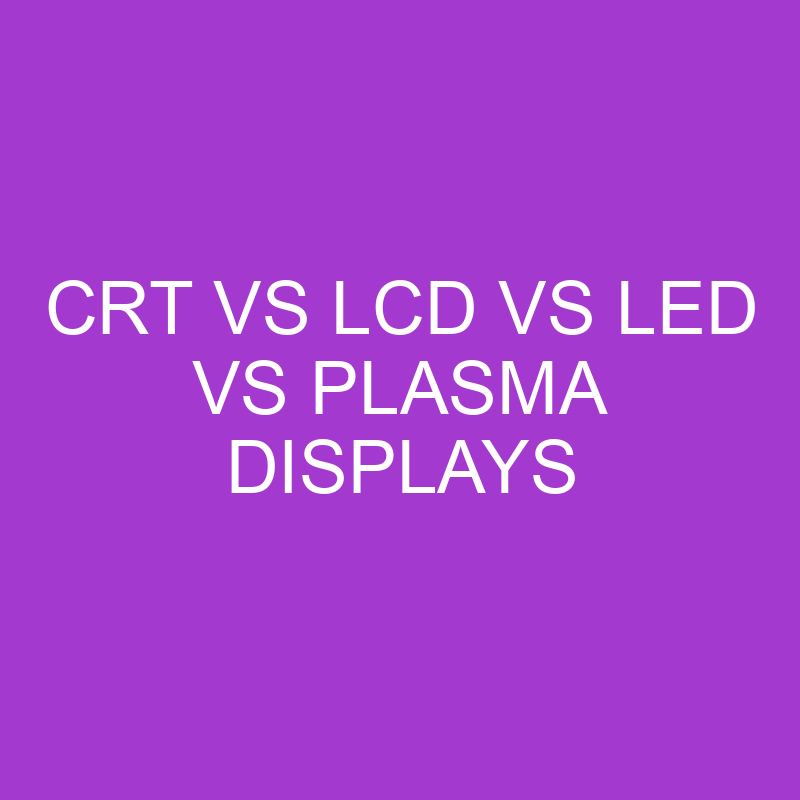Unveiling the Display Odyssey: A Comparative Exploration of CRT, LCD, LED, and Plasma Technologies
In the dynamic landscape of display technologies, the choices between CRT, LCD, LED, and Plasma have profound implications for visual experiences across various devices. This comprehensive exploration delves into these display technologies’ origins, characteristics, and applications, shedding light on their strengths, weaknesses, and evolving roles in the ever-changing world of visual displays.
The Evolution of Display Technologies:
CRT (Cathode Ray Tube):
Overview:
Cathode Ray Tube (CRT) was the pioneer in display technology, dating back to the early days of television and computer monitors. It employs electron beams striking phosphorescent pixels to generate images.
Key Features:
- Analog Technology: Utilizes analog signals for image generation.
- Deep Contrast: Offers deep blacks and rich colors.
- Viewing Angles: Generally provides consistent viewing angles.
Limitations:
- Bulky Design: CRT displays are bulky and heavy.
- Limited Sizes: Limited scalability for larger screens.
- Power Consumption: Consumes more power compared to newer technologies.
LCD (Liquid Crystal Display):
Overview:
Liquid Crystal Display (LCD) technology revolutionized the display industry by using liquid crystals sandwiched between two layers of glass. When an electric current is applied, the crystals align to control the passage of light.
Key Features:
- Slim Profile: Thin and lightweight compared to CRT.
- Sharp Images: Produces sharp and clear images.
- Energy Efficiency: Generally consumes less power.
Limitations:
- Limited Viewing Angles: Viewing angles can be restricted.
- Backlight Dependency: Requires a backlight for visibility.
- Response Time: May have slower response times.
LED (Light-Emitting Diode):
Overview:
Light-Emitting Diode (LED) displays build upon LCD technology but replace the traditional fluorescent backlight with LEDs. This alteration enhances brightness and color accuracy.
Key Features:
- Energy Efficiency: More energy-efficient compared to LCD.
- Brightness: Offers higher brightness levels.
- Slim Design: Maintains a slim and sleek profile.
Limitations:
- Cost: Initial cost can be higher.
- Uniformity: May face issues with uniformity in backlighting.
- Limited Viewing Angles: Similar limitations to LCDs.
Plasma:
Overview:
Plasma display technology utilizes ionized gases to create pixels. Each pixel is self-illuminating, eliminating the need for a backlight. Plasma displays were popular for large-screen TVs.
Key Features:
- Wide Viewing Angles: Maintains consistent visibility across angles.
- Color Accuracy: Offers vibrant and accurate colors.
- Contrast Ratio: Excellent contrast with deep blacks.
Limitations:
- Weight: Plasma displays can be heavy.
- Power Consumption: Consumes more power compared to some technologies.
- Screen Burn-In: Susceptible to screen burn-in issues.
Applications and Considerations:
Choosing the Right Technology:
Home Entertainment:
- CRT: Phased out for larger screens but may evoke nostalgia.
- LCD and LED: Commonly used for modern TVs, balancing performance and cost.
- Plasma: Was popular for large-screen TVs but phased out.
Computer Monitors:
- CRT: Obsolete in modern computing due to size and weight.
- LCD and LED: Dominant technologies for computer monitors.
- Plasma: Rarely used for computer monitors.
Public Displays:
- LCD and LED: Widely used in public spaces, digital signage, and information displays.
- Plasma: Less common due to size and power consumption.
Conclusion:
The world of display technologies has witnessed a remarkable evolution, from the bulky CRT to the sleek LED displays. Each technology brings its own set of strengths and limitations, catering to diverse needs and preferences. Whether it’s the energy efficiency of LED, the color accuracy of Plasma, or the historical charm of CRT, the choice of display technology depends on the specific requirements of the application. As technology continues to advance, the display landscape will undoubtedly see further innovations, shaping the visual experiences of generations to come.
